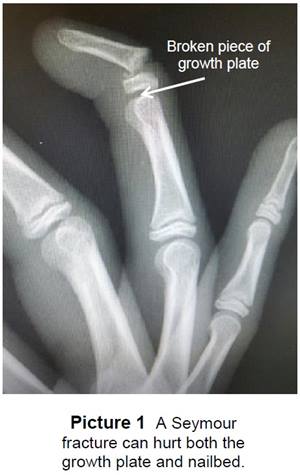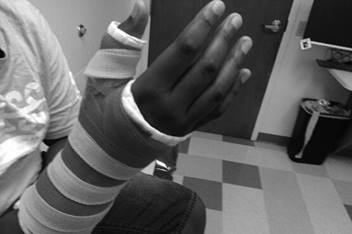Seymour Fractures


A Seymour (see-more) fracture is a break in the bone at the end of the finger or toe at the first
joint (Picture 1). It often happens when a finger
or toe is crushed or bent back too far.
In children, there is a growth plate at the end of
their bones. It is the weakest part of the bone
until the bone stops growing. Where a nail starts
to grow (nailbed) is located near the growth plate.
With a Seymour fracture, when a nailbed gets crushed, it can push and trap skin (tissue) in between the broken growth plate and the bone.
This may affect healing and cause problems
with how the bone and nail grow.
If you think your child has a Seymour fracture,
take them to an emergency department or urgent care right away.
Signs and Symptoms
- Swelling
- Bruising
- Pain or tenderness at the joint
- A cut or open wound (laceration)
- The finger or toe is bent from where it should be
- Bleeding at the edge of the nail (cuticle) or under it
Diagnosis
A doctor or health care provider will ask what happened, examine your child, and take X-rays of the finger or toe.
Treatment
Treatment depends on how bad the injury is. The quicker your child starts treatment, the better chance the bone will heal without any problems.
- In the emergency department, the doctor or health care provider may numb and clean the injury first. Your child may need:
- The nail removed.
- The broken bones set straight, and a splint or cast put on. This will stop the finger or toe from moving and keep the bones in the right place.
- Stitches (sutures).
- A bandage. The doctor or health care provider will tell you how to change the bandage.
- Antibiotics to prevent infection. Your child must take the antibiotics as ordered. This reduces the chance of infection.
- Your child will need to see a bone doctor (orthopedist). They will see your child for all follow-up appointments to make sure the fracture is healing well.
- Your child may need to do special exercises to get strength and flexibility back. Exercises can help with stiffness.
What to Do at Home
- Do not take a bandage, splint, or cast off unless your child’s doctor or health care provider says you can.
- Keep all dressings, splints, and casts clean and dry.
- Your child should not take part in sports or gym until their doctor or health care provider says they can. Give your child over-the-counter (OTC) pain medicines, such as acetaminophen (Tylenol®) or ibuprofen (Advil® or Motrin®), if needed. Read the label to know the right dose for them.
What to Expect
Seymour fractures may cause problems like:
- Infection inside the bone or skin
- Stiffness
- The nail may not grow back the way it was before the injury
- The end of the finger or toe may look bent or misshapen
- The bone stops growing (growth arrest)
When to Call the Doctor
Call your child’s doctor or health care provider if they have any of these signs of infection:
- Pain that’s getting worse
- Redness, red streaks, or swelling that doesn’t go away
- Thick, yellow, or green fluid (drainage) coming from the wound
- A bad smell
- Fever or temperature over 101° Fahrenheit (F) or 38.6° Celsius (C)
HH-I-412 • ©2016, revised 2023 • Nationwide Children's Hospital
Treating Seymour Fractures
The Hand and Upper Extremity Program expertly cares for children with seymour fractures.


